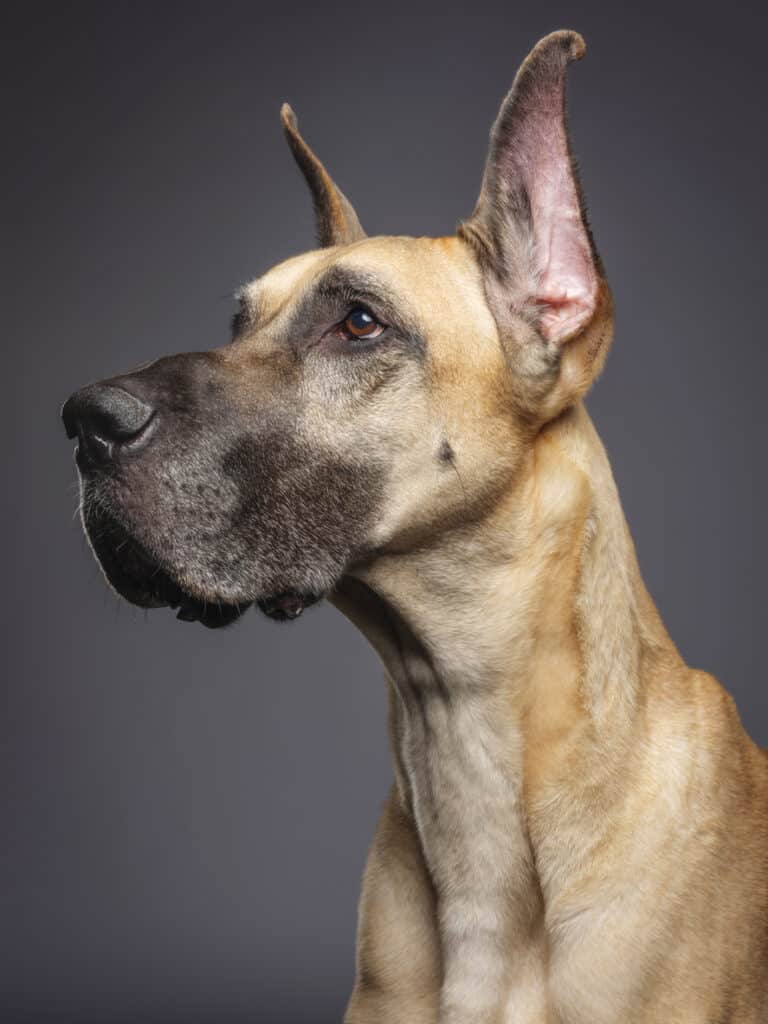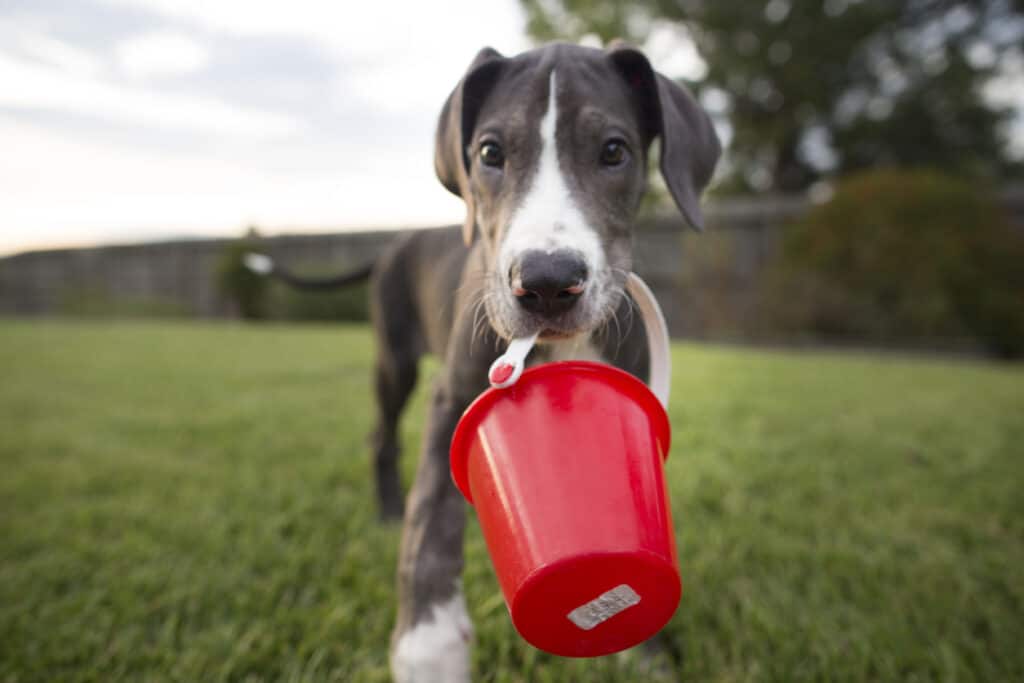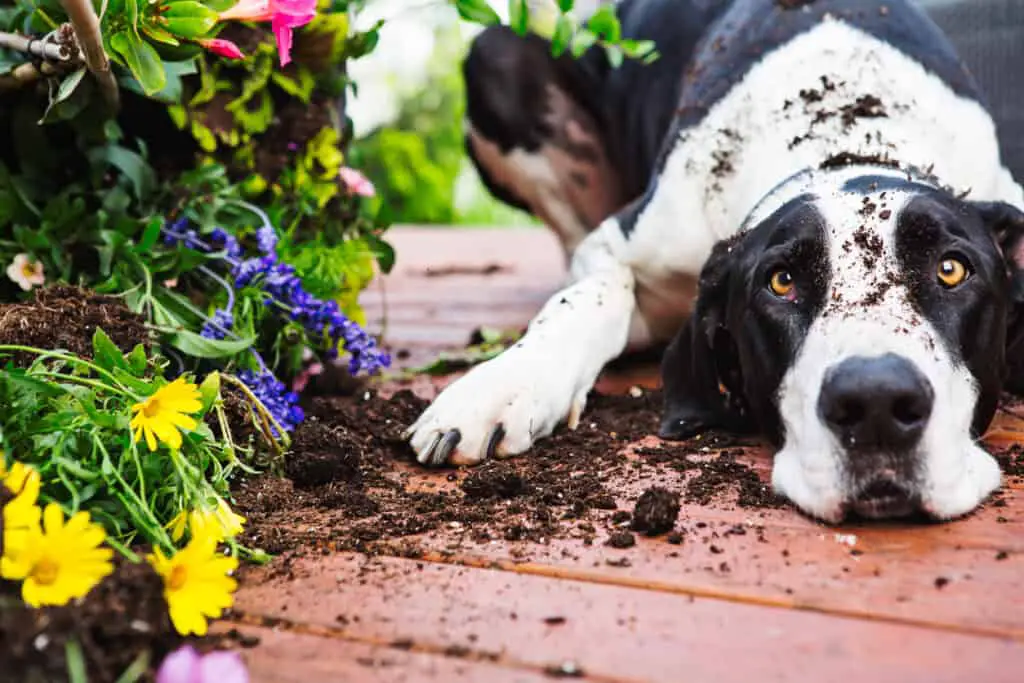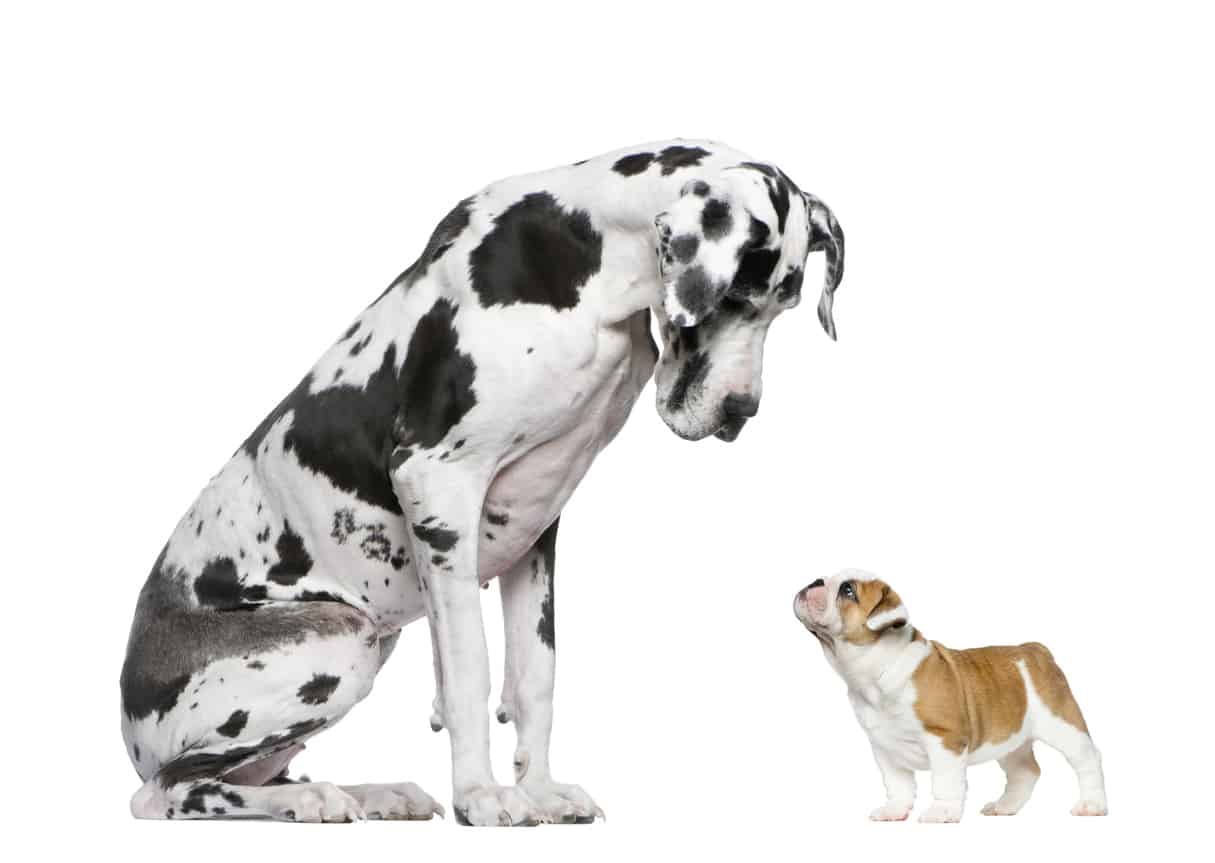Great Danes are a short-furred dog that are known as “gentle giants.” They come from Germany and are known for being loyal and family-friendly dogs. They are also one of the largest dog breeds, with females reaching, at minimum, 28-30 inches at the shoulder and males at least 30-32 inches. Although they are a short, single-coated dog, their sheer size and weight, (somewhere between 100-200 pounds when fully grown), make them moderate-to-high shedders. They’re simply so large and have so much fur!

Fortunately, Great Danes are not double coated like other popular large family dogs such as the Bernese Mountain Dog or the German Shepherd. Double coated dogs have two layers of fur: a top layer that serves as a water repellant and a second layer that serves as insulation. An extra layer means more fur to shed and a thicker coat to care for.
Great Danes, for their part, simply have a single coat. Their fur is soft, strong, and short, and they typically go through one full shed once a year in the spring. Officially, the major shed that occurs during this time is known as “blowing” a coat.
Springtime is a natural period for dogs to shed their coats because the change in season signals warmer times to come. During this time, you may want to brush your Great Dane more often because there will be an increase both dander and fur in your home.
To understand more about the nature of shedding and how to manage it, it can be helpful to know about the life cycle of your dog’s hair follicles.
There are four stags to the growth cycle of a Great Dane’s hair follicles:
- The growth phase (officially known as the Anagen Phase) is the beginning of the cycle and marks when new hair is growing.
- The transition phase (officially known as the Catagen Phase) is when the hair has completed its growth. Its length plateaus and hair follicles begin to shrink and detach from the skin, but do not fall out.
- The resting phase (officially known as the Telogen Phase) is when the hair is neither growing nor shedding, but a new hair enters the growth phase beneath it.
- The New Hair phase (officially known as the Exogen Phase) marks the end of the hair’s life cycle. At this point, the old hair falls out so that the new hair has room to grow into its place.

Not every dog breed experiences the growth cycle at the same speed. For example, mild shedders will spend more time in the first phase. The thickness of the coat also plays a role, as does the season. With Great Danes, their size plays the biggest role in the degree of shedding experienced by their owners – there is just more of their body to rub up or on items that hair might stick to. This is especially likely given the Great Dane’s tendency to act like a lapdog and attempt to snuggle or crawl into your lap with you. Additionally, they can be quite the “Velcro dog” in the sense that many adore their owners so much that they follow them around the home as if they were “Velcro-ed” to the person’s leg. Needless to say, while endearing and cute, these tendencies can contribute to shedding.
Many prospective dog owners are interested in hypoallergenic dogs. Hypoallergenic dogs are marketed as dogs that do not cause allergic reactions in people who are allergic to dogs, but no dog is 100% hypoallergenic. When someone says their dog is hypoallergenic, what they mean is that their dog produces a very low amount of dander. Standard Poodles are excellent examples of low-dander dogs due to their low-shedding coats and the curly nature of their fur – dander gets trapped in the fur, so diligent owners can remove it before much has time to disperse across carpet, furniture, or people’s hands.
Because Poodles’ shedding is so manageable, they have become a popular breed to cross with other breeds that are typically more high maintenance when it comes to grooming. In so doing, popular breeds such as the Goldendoodle, Bernadoodle, and many others now exist. There is even a Great Dane-Poodle cross, known as a Great Danoodle!

If you love Great Danes but someone in your household needs a dog that produces as little dander as possible, this hybrid could be an option for you. However, prospective owners should proceed with caution as the mix is fairly new and therefore not all of the health risks associated with mixing the breeds are known – but it’s certain that major concerns such as bloat remain or are even exacerbated due to the fact that Standard Poodles are another breed at high risk of developing bloat.
While Great Danes are not hypoallergenic, there are steps people can take to reduce the amount of dander released into their home. Removing carpet and investing in leather furniture are two such steps, in addition to vacuuming regularly and grooming your Great Dane outside.
How to brush a Great Dane
Brushing is considering one aspect of grooming. Grooming refers to the overall hygiene routine you provide your dog. Generally, brushing your Great Dane one or two times per week will be sufficient to remove any buildup of dead hair, dirt, and dead skin cells. Dead skin cells are associated with the dead fur and are what causes the dander that make some people allergic to dogs. By brushing your Great Dane regularly, you can also ease allergy symptoms in people with mild symptoms.
You should begin brushing your Great Dane puppy as soon as possible to familiarize your pup with the brush, as well as to raise an obedient and cooperative pet. If possible, take your Great Dane outside and have them stand or sit (as a puppy, you will also be reinforcing training at this time, so extra patience will probably be necessary).
Beginning at the neck, take a soft rubber brush and brush downwards in order to encourage the dead fur to come out naturally. Rubber brushes are encouraged to use on Great Danes so that the sensation of being brushed feels pleasant rather than stressful. Just like humans, the texture of a dog’s hair influences the best type of brush. Because Great Danes are short haired and single coated, rubber brushes feel more pleasing than anything metal or bristly.
You can brush the dog’s legs lightly, but take extra time with areas where the fur is more tightly compacted, such as at the base of the neck, the chest, and the base of the tail.
A grooming routine should also include ear and teeth cleaning, as well as nail trimming. As these are all tasks that are fairly tedious as a baseline, it’s important to teach your pup to respect the grooming process early on to stave off uncooperative behavior later.
Incorporating praise and treats is a good way to help form positive associations with the routine. Another option here is to outsource this part of grooming to a professional. Doing so has some pros and cons that you will want to consider before making a decision based on your Great Dane.
For example, if you have the resources from the outset, taking your Great Dane puppy to the groomer has the added benefit of increasing their exposure to novel stimuli (socialization) which is necessary for the health of the Great Dane. However, groomers can also be a source of anxiety or stress for dogs due to the busy nature of public dog spaces, so you will want to consider your Great Dane’s temperament carefully. If your Great Dane has a more excitable or anxious personality, it may be best for the health of the dog if you learn to do the grooming routine yourself, or perhaps consider hiring a private groomer to come to your home in-person to provide the service.
Stress is thought to instigate bloat in Great Danes, which is a life-threatening stomach condition. Thus, if you decide to send your Great Dane to a groomer, take care to monitor their behavior before and after, as well as discuss with the groomer regarding their overall appearance throughout the appointment.
What is the ideal Great Dane coat?
A healthy Great Dane will have a glossy, smooth coat. It will shed moderately, but this should be manageable by the owner via preparations and routine. Great Danes come in several pleasing colors, which can be another factor to consider when determining which puppy to bring home – if you have mostly dark furniture for example, a Dane with darker-colored fur may be advisable.
Other factors determining the health of a Great Dane’s fur
Great Danes are extremely influenced by the type of food they consume. Similarly to how human skin often reflects the quality of a diet, a dog’s coat may reflect the quality of the food they’re eating. Of course, most owners would never knowingly feed their Great Dane foo that was less than top notch, but Great Danes have very unique nutritional needs, especially as puppies.
Great Dane puppies have what is referred to as an extended growth phase, meaning that they spend more time growing than other puppies. Additionally, within the same timeframe as other puppies, they simply grow so much more that it’s important that their diet be carefully designed to support that growth and adjusted as necessary.
Owners of Great Danes should enjoy tracking and recording details, because this skillset will be invaluable when following the growth of your Great Dane. As they grow, Great Danes will consume anywhere from 2,500-3,000 calories of food per day, eventually leveling off to around 2,500 per day as an adult.
It’s advised to avoid food that has soybean meal, oil, or fat listed in the first four ingredients. Your veterinarian will be able to provide recommendations regarding food brands and guidance regarding when to feed your Great Dane. It is advised to provide several portions of food throughout the day rather than just one large serving, as this can trigger severe stomach problems. Your Great Dane’s coat can be a great resource in getting an accurate read on the overall health of the dog. For example, Great Danes suffer from dry skin, for which Omega 3s are useful in mitigating. Omega 3s are a type of fatty acid that provide good fat to your dog.
Some Great Danes may naturally shed a bit more than is usual for the breed. Once you have ruled out potential health issues by observing and perhaps consulting with your veterinarian, you can discuss introducing a natural home shedding remedy to ameliorate the situation. For example, coconut oil can be added to food (in moderation) to promote a healthy coat that does not cycle through the hair growth phases so quickly.
Learning about which aspects of your Great Dane’s care can be improved or changed in order to foster a strong, healthy coat is a great way to ensure the long-term health of your dog, as well as minimize shedding.

